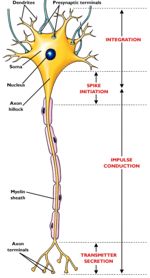Difference between revisions of "Neurotransmitters - Anatomy & Physiology"
(New page: {{unfinished}} {{toplink |backcolour =E0EEEE |linkpage =Nervous and Special Senses - Anatomy & Physiology |linktext =Nervous and Special Senses |maplink = Nervous System and Special Senses...) |
|||
| Line 1: | Line 1: | ||
{{unfinished}} | {{unfinished}} | ||
{{toplink | {{toplink | ||
| − | |||
|linkpage =Nervous and Special Senses - Anatomy & Physiology | |linkpage =Nervous and Special Senses - Anatomy & Physiology | ||
|linktext =Nervous and Special Senses | |linktext =Nervous and Special Senses | ||
Revision as of 14:09, 14 August 2009
| This article is still under construction. |
|
|
Introduction
Neurotransmitters are chemicals that are used to relay, amplify and modulate signals between neurones and cells.
Types of neurotransmitter
These include:
- Acetylcholine (Ach)
- Monoamines - epinephrine (E), norepinephrine (NE), dopamine (DA), serotonin (5-HT) and melatonin.
- Three or four amino acids, depending on exact definition used: primarily glutamic acid, gamma aminobutyric acid (GABA), aspartic acid & glycine.
- Purines -(Adenosine, adenosine triphosphate (ATP), Guanosine triphosphate (GTP) and their derivatives.
- Peptides - vasopressin, somatostatin etc.
- Histamine (HA)
- Single ions - such as synaptically released zinc.
- Gaseous - nitric oxide (NO) and carbon monoxide (CO).
Function
Release of excitatory neurotransmitters from the presynaptic membrane cause channels in the postsynaptic membrane to open and cause an increase in sodium ion concentration within the postsynaptic cell and a decrease in potassium ion concentration. This leads to a depolarisation of the postsynaptic cell, which is propagated further along the axon by an action potential (AP).
Inhibitory neurotransmitters cause hyperpolarization of the postsynaptic cell making it unable to generate an action potential.
Receptors determine the reaction of the neurotransmitter meaning that the same neurotransmitter may cause an excitatory effect on some membranes whilst an inhibitory effect on others e.g ACH can be either excitatory to skeletal muscle cells or inhibitory to both smooth muscle and cardiac muscle.
Actions
| Neurotransmitter | Action |
|---|---|
| Acetylcholine (Ach) | Skeletal muscle movement (sympathetic)
Visceral movement (parasympathetic)
|
| Epinephrine | As norepinephrine, produced by adrenal glands. |
| Norepinephrine | Conciousness (sympathetic). |
| Dopamine | Addiction, love, motivation. |
| Seretonin | Emoticon, conciousness, sleep and thermoregulation. |
| Melatonin | Regulates the onset of sleep and seasonal changes in the body e.g winter weight gain. |
| ATP | Timing mechanism of G proteins by displacement of ADP. |
| GTP | Timing mechanism of G proteins by displacement of GDP. |
| Vasopressin | Metabolic rate, metabolism. |
| Somatostatin | Inhibits production of other hormones. |
| Histamine | Gastric secretions increased, dilation of capillaries, constriction of bronchial smooth muscle and decreased blood pressure. |
| Zinc | Release of neuropeptide Y. |
| NO | Enlargement of genital organs leading to erection. |
| CO | Sleep cycle. |
| Glutamate | Exitatory, found in CNS. |
| GABA | Inhibitory, found in CNS. |
| Glycine | Spinal reflexes, motor. |
Neurotransmitter systems
See somatic and autonomic nervous systems.
Degradation and elimination
- Acetylcholine is derived from Choline.
- Serotonin [5-Hydroxytryptamine (5-HT)] is derived from Tryptophan.
- GABA is derived from Glutamate.
- Histamine is derived from Histidine.
- Epinephrine, norepinephrine and dopamine are derived from Tyrosine.
- Adenosine is derived from ATP.
- Nitric oxide is derived from Arginine.
Neurotransmitters must be broken down once they reach the post-synaptic cell to end the excitatory or inhibitory signal and prevent over stimulation/perminent inhibition.
- e.g, ACH an excitatory neurotransmitter, is broken down by acetylcholinesterase (AchE).
- Choline is taken up and recycled by the pre-synaptic neuron to synthesize more ACH.
- Other neurotransmitters such as dopamine are able to diffuse away and are eliminated from the body via the kidneys, or destroyed in the liver.
